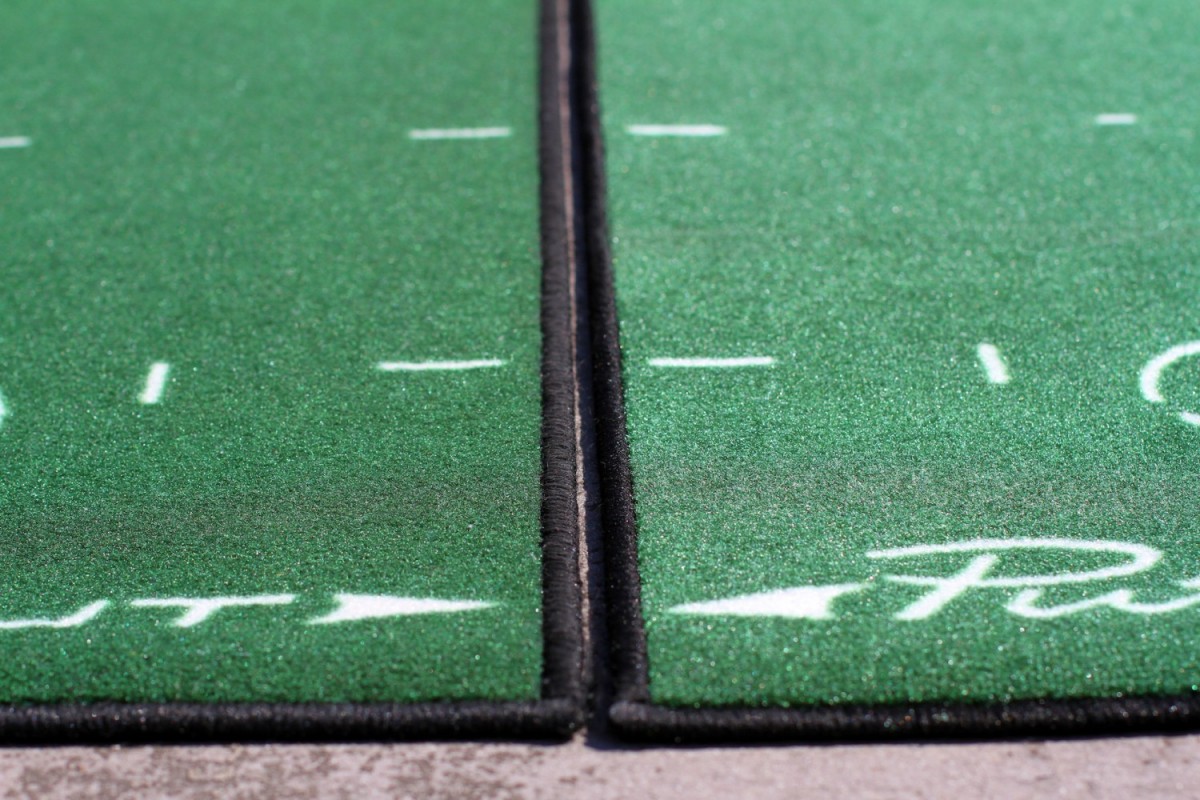-
Posts
6 -
Joined
-
Last visited
Content Type
Profiles
Forums
Articles
FAQ
Tests
Classifieds
Store
Group Buys
Everything posted by PuttOUT
-
We in here. Great stuff, HL, on the improvement and on the promotion (...surely it can't be *all* bad!)
-
Great stuff, @tommc23. It's falling into what we've always wanted for those trying our products from the beginning: to get more people practicing and really giving themselves the chance to improve... and that's exactly what it sounds like you're doing! As a side note, with the amount of trade shows, events and in seeing people first-hand, it really does become evident that it's not a lack of skill in improving putting, it's the lack of willingness to try. Now being an MGS contributor, it probably won't be those on here who have a golf-defeatist mindset but if someone approaches us to see what's happening, we'll often ask them if they're a good putter with the answer almost certainly being one of two responses: 1) "I'm a great putter, I don't need to practice" 2) "I'm a terrible putter, it won't help" Our big goal is to try and design products that actually make people want to practice. Over time, this will lead (please, please, please) to inevitably noticing tendencies which you can either decide to adjust (with or without a teacher's guidance), or roll with them and know how to use them to your advantage (see Tiger toe strikes: https://bit.ly/2JV2xK4). In any case, you know your stroke better so hearing that you're making what you feel are helpful adjustments that aren't simply a fleeting idea from a friend* but are built on real testing... THAT is the music to our ears. Bravo, T23. Keep on the grind. *Hey, we'll all do it.
- 175 replies
-
- putting
- trainingaid
-
(and 2 more)
Tagged with:
-
*dabs with delight* Well that's very kind of you @Golfspy_CG2. Let's hope the products help you as well as everyone else take the part of the game which there really shouldn't be any excuses for lacking to the next level. Here. We. Go.
- 175 replies
-
- putting
- trainingaid
-
(and 2 more)
Tagged with:
-
All. In. Yup @Kanoito, it should be as simple as that. In fact, we've kept one specific model in our London office to see how it wears and develops with (A LOT) of use: I've attached a picture of a 1.5 year old (left) and brand new (right) mat below to demonstrate the difference in appearance over time. As you can see, although the surface hasn't changed a whole lot, the new mat is a more sparkly with the fibres standing on end in the sunlight, whereas the 1.5 year-old mat is more of an unvaried colour throughout. This is because the fibres have been flattened out across the whole mat over hundreds of hours of putting/grind/obscure product development brainstorms. Of course, if you do want to keep the mat staying at its most sparkliest for longer, the easiest thing to do along with brushing it is to vary the lines you putt on. So instead of just putting down the single central line, try mixing it up and putting with the two other parallel side lines, from the opposite end, or even across the mat diagonally and see how you fare. Fingers crossed this is a help but if you have any more questions, fire them over and we'll be right here to answer them posthaste! Cam
- 175 replies
-
- putting
- trainingaid
-
(and 2 more)
Tagged with:
-
Well good afternoon to everyone from here in sunny London, My name is Cam, and I'm part of the PuttOUT team and wanted to see if I could jump into the conversation and directly answer any queries or questions you had, along with following up on what's been touched on so far (I'm also the one who put those little notes in the box so greetings on another platform). From the sounds of things, it looks like the first reaction to the products themselves have been great (woo!), followed by moment from a few testers of shock when checking stroke, alignment and setup. For those concerned, don't worry, from experience we've found this to be a pretty normal part of getting into a proper practice routine, and clearly there's already been some realisations and 'corrections' hopefully leading to improvements! Double whammy. So firstly, a big thank you to MGS, specifically @GolfSpy MPR, @GolfSpy STUDque and @Golfspy_CG2 for asking us to come onboard with the renowned MGS Member Testing. It's truly a privilege. Secondly, a thank you to all the testers themselves (@Kanoito, @HardcoreLooper, @Peaksy68, @tommc23 and @gaussman1) for taking up their time, getting stuck in and offering their opinions and feedback on our first three products - mat, mirror and trainer. Obviously there's a lot that goes into being thorough in testing so I can assure you that we're all very grateful here for your hard work. Thirdly, thank you for all the exceptionally nice comments so far on different aspects of the products. It's fantastic to hear that the small details have not been taken for granted and it makes the toiling over the seemingly insignificant bits worthwhile (when it took us five rounds of prototyping just to get the cardboard tube used inside the mat packaging the way we'd like it, you quickly realise it's the tip of the iceberg). 1. The first thing that came to our attention was the question about the height of the mirror from the ground so let's see if we can offer a little more detail and get a few more thoughts from there: The mirror itself is made up of three individual parts: a back-printed acrylic mirror part (1.5mm), a steel inner plate (1mm), and a spiked rubber outer that encases everything as one (5mm). To put this into perspective, the industry standard putting mirror stands fairly consistently at 3mm (a little less than two stacked quarters). This could have been the goal but we saw it as an unrealistic one when adding two extra layers onto what already exists. It should be noted that it did come up amongst us and we wanted to put our own minds at rest so in prototyping we sent out more than a dozen mirrors to PGA professionals, tour pros and equipment geeks with one of the follow-up questions being: "does the height cause any issues?" Without exception or prompting, the answer was that it wasn't a problem for anyone who uses or has used a mirror before. The only way we believe we could have made the product any thinner would be by glueing it all together instead of creating a casing. However this option would have meant more cost, risk of quality control (imagine trying to perfectly align and ensure the correct gluing of 30,000 three-part mirrors!), but most of all would have meant that inevitably the glue would have become unstuck. We tried to design our mirror to theoretically last forever, with the removable outer casing, it means you can take the product apart, clean it, and put it back together without any faults creeping up over time. 2. The second question that has come up so far is about our mat forming a very small ridge along the central putting line. This is an interesting one but rest assured it has a happy ending. As mentioned, we went through five rounds of prototyping simply for the mat packaging so that's a little precursor of how much care went into making the product itself!: In creating our mat, to start off we looked at what already existed on the market and decided that there were two categories of putting mats: either the absolute top of the line putting mats out there which were very expensive, immoveable and often a rigid, permanent structure; or the more temporary options which were very low-quality, felt cheap and had constant problems (as well as big return and refund rates from retailers). We wanted to be the ones who designed a product that was great quality, discreet and portable, as well as affordable to those who didn't want to spend a huge amount kitting out an at-home studio (I know, it's the goal for us all someday). When it comes to the possibility of a ridge being created through use, we like to use the analogy of the humble tennis ball: when the ball comes out the tube, the fibres are long but compact to the rubber inside the ball. Over a few games, the fibres begin to stand on end and become more 'fluffy', but then over time they become shorted from wear and flattened again with use. This is the same principle we applied to our putting mat: it comes out the tube and the fibres stand on end with complete uniformity. With a bit of rolling the ball down the same line over and over in a practice session, they can begin to lay down only on that one line. Over time as the mat is used more and more, the fibres flatten across the entire surface, creating an even smoother roll all across the putting surface. Where some products wear and deteriorate over time, we've found that this is one that actually gets better with play, and like our putting mirror, will last as long as you want to use it for. (We'd love to claim this bit as our lightbulb/genius/foresight moment, but really it was something we only discovered as we put our prototypes through the testing phase back in 2017 before launch) In the meantime, the solution to any ridges is a nice, quick fix: just rough up the surface and then smooth down the fibres with your hand back to their original state aaaaand we're back! Hopefully this is a nice little hello from us and has answered the two questions that have come up in testing so far, BUT we're here to get the best possible feedback from you to help us do even better going forward. We're doing everything we can to make the best products out there and you've shown incredible support in helping us get to a position where we can keep going and keep creating so when you have a question, just shout because with any luck, we're here for the long run. Cam
- 175 replies
-
- putting
- trainingaid
-
(and 2 more)
Tagged with:





